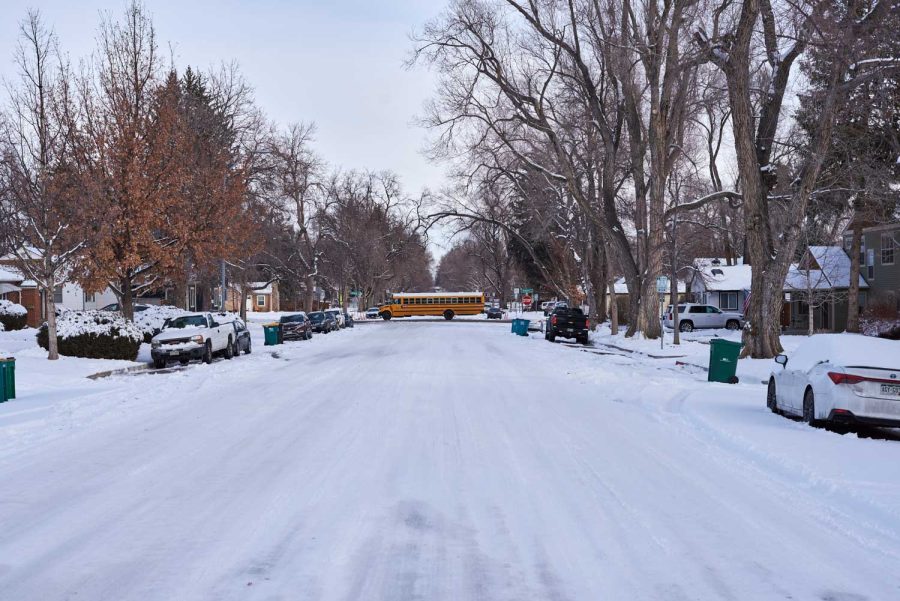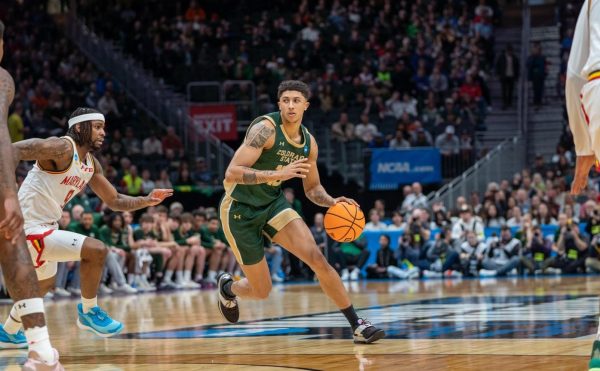Lacking snow removal affects people at CSU with disabilities
Collegian | Reuel Indurkar
West Myrtle Street and South Grant Avenue, along with many other residential streets, remain unplowed days after the last snowfall while larger streets such as West Mulberry Street are plowed and supporting traffic flow Jan. 20.
Abby Flores
February 13, 2023
Editor’s Note: Read the Spanish version of this article here.
In the winter seasons, snow and ice buildup create potentially hazardous conditions for all, but these issues can disproportionally impact people who may have physical disabilities.
Community members with disabilities at Colorado State University are likely to face more adversity when trying to get around town and campus, especially when roads, parking lots and walkways are not well maintained.
There are efforts being made when it comes to plowing, shoveling, de-icing and salting certain public areas, but on campus and around Fort Collins, these efforts are often not sufficient to effectively help members of the disabled community.
Many different accessibility and mobility tools exist for different purposes, but there are a few that are particularly challenging to use in snowy and icy conditions, such as crutches, wheelchairs and scooters. These tools help people with all kinds of conditions be more independent but typically depend on a clear path to operate.
Rory Low, a CSU student and Associated Students of CSU member, expressed some of the issues they’ve faced in relation to mobility on campus and around town. Low spoke about how they formerly used forearm crutches to help with mobility but have recently made the switch to a wheelchair with SmartDrive power assist.
Low said one of the difficult aspects of this switch is “being confronted with how inaccessible so many things are.”
“The ice has been a huge risk to me,” Low said. “Sometimes they shovel the sidewalk to the point where I don’t even have clearance for my wheelchair.”
“If things were built with inclusive design, then people would not have to change or accommodate for themselves.” -Ariadne Athey, ASCSU member and CSU student
Low lives in an off-campus apartment and regularly rides the bus to get around. At the stops, a section is carved out for people to walk through, but large piles of snow get in the way of the wheelchair-assist platform.
“Sometimes they don’t plow around the stops, which so many people rely on,” Low said.
Low said the recent transition to a wheelchair has been completely liberating. Using crutches before allowed Low to do other things such as going up stairs. Even then, snow and ice buildup made this very dangerous.
“There are a lot of challenges I didn’t expect to face, but I didn’t expect how awesome having a wheelchair would be,” Low said.
After a short time, they have come to realize the level of effectiveness with which the wheelchair accommodates their disability.
“It has truly changed my life … and given me the ability to be outside again with good energy levels and far less pain than walking,” Low said.
CSU student and member of ASCSU Ariadne Athey also experiences some difficulty with mobility in winter conditions. Athey has a condition that causes severe pain, especially when walking. She too described the transition to using a wheelchair as liberating, as it allows her to travel farther and longer to more places.
“It started in ninth grade and progressed from there,” Athey said. “All of high school, I was climbing ladders (and) doing things as a stage manager, but by my senior year, I had to drop out of theater stuff and did my last semester from home.”
Living off-campus as well, Athey drives to campus but acknowledges that if she didn’t drive or make it on the bus, then there would be no way to travel from her complex to campus when ice and snow are a factor. One reason for limited mobility in the snow is the SmartDrive function on many wheelchairs.
“If I were to roll over an ice chunk, my SmartDrive would just pop up, and then it doesn’t work, and then I’m stuck,” Athey said.
“The biggest thing that I find on campus is that the buttons aren’t going to work,” Athey said, referring to the accessibility buttons on many doorways. “The tiny bits of access they give are broken down or aren’t there.”
Athey gave one specific example, describing how the outside of the south and southeast sides of the Lory Student Center are regularly neglected, and snow and ice buildup make it difficult to enter the ASCSU chambers and the food pantry.
“Even though it’s technically covered, the wind blows snow under, and they never plow it, … and I’ve called them multiple times, … and there’s still snow,” Athey said.
“If things were built with inclusive design, then people would not have to change or accommodate for themselves,” Athey said.
The same goes for how things are maintained. If CSU and Fort Collins invested more in clearing roads, lots and walkways, then more spaces would become more accessible for all people, especially those with disabilities.
Reach Miles Buchan at life@collegian.com or on Twitter @buchanmiles.





